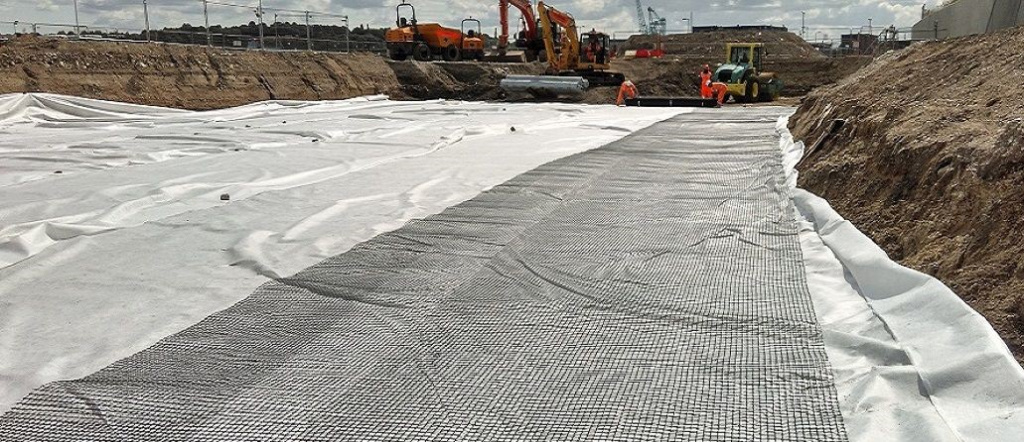Geotextiles are permeable fabrics that, when used in association with soil, have the ability to separate, filter, reinforce, protect, or drain. They can consist of natural materials such as jute, or synthetic materials such as polypropylene, polyethylene or polyester. When installed in civil engineering projects, geotextiles reinforce soft, loose soils and bases, and separate dissimilar materials. They are used widely in road construction, erosion control, foundations, retaining walls, and drainage applications.
Types of Geotextiles
Geotextiles are manufactured for specific construction functions:
– Separation: These geotextiles are used to prevent intermixing of two dissimilar materials. Examples include preventing fine soil particles from clogging drainage media or preventing contaminated soils from mixing with good soils.
– Reinforcement: Geosynthetics classified as geogrids or geotextiles are used to increase the shear strength of soils and bases. This prevents cracking and rutting. Examples include stabilizing unpaved roads over soft soils.
– Filtration: Special geotextiles are designed to allow water to pass through while retaining fine soil particles or fine aggregate. They prevent clogging of drainage systems. Examples include separators and filters around drainage pipes and behind retaining walls.
– Protection: Geotextile are used as cushions to prevent damage to membranes or coatings. They also protect sensitive fine-grained subsoils from external disturbances or intrusion by aggregate. Examples include protecting synthetic liners from sharp aggregate or protecting subgrades from construction traffic.
– Drainage: Geotextiles aid the lateral movement of water when used in drainage applications. Examples include wrapped drainage trenches or cross drains.
Applications in Road Construction
Geotextiles have numerous applications in road construction to provide stability and drainage. Some common uses are:
– Reinforcing road subgrade and sub-base layers over weak soils: Geogrids or nonwoven geotextiles distributed through unpaved road bases increase the structural integrity.
– Separating subgrade from sub-base: Geotextiles prevent contamination and mixing of dissimilar materials like clays into the drainage layer.
– Protecting unpaved shoulders from erosion: Geocells or turf reinforcement mats stabilize shoulders and slopes.
– Extending pavement life in overlays: Interlayers of geotextiles distribute stresses and reduce reflective cracking in asphalt overlays over cracked slabs.
– Draining pavement structures: Geocomposite edge drains and cross drains sheet drain water out from the base and subgrade layers.
– Stabilizing soft roadway shoulders: Geogrid or geotextile reinforced aggregate shoulders prevent lateral spreading on soft soils.
So in summary, geotextiles improve the structural performance of roads by reinforcing, separating, filtering, draining and protecting different pavement layers. This leads to longer life and reduced maintenance costs of these vital transportation infrastructure assets.
Applications in Erosion Control and Slope Stabilization
Control of soil erosion and stabilization of vulnerable slopes are important environmental protection applications of geotextiles. Some specific uses are:
– Reinforcing turf and vegetation establishment on vulnerable soils: Turf reinforcement mats accelerate grass growth and reinforce soil on steep slopes to prevent erosion.
– Stabilizing channels and ditches: Geotextiles line channels to prevent scouring and sloughing of soils during water flow.
– Controlling sediments in runoff: Filter fabric fences and barriers trap sediments in surface runoff before they pollute waterbodies.
– Reinforcing retaining walls and steep slopes: Geogrid layers or sheets provide tensile strength to reinforce retaining walls and steep slopes made of loose soils.
– Reclaiming disposal areas: Large geotextile sheets are used to contain contaminated soils and stabilize fill slopes at landfills and mining sites.
Thus geotextiles protect the environment by controlling erosion, stabilizing vulnerable soils and helping vegetative establishment. This contributes to mitigating land degradation and preventing pollution of water resources.
Quality Considerations
For geotextiles to fulfill their intended functions, certain quality-related properties must be considered:
– Material composition: Polypropylene and polyester based wovens and nonwovens are commonly used.
– Thickness: Depends on severity of application but typically 2-10mm.
– Tensile strength: Minimum required strength for temporary or permanent reinforcement applications.
– Puncture and tear resistance: Rated for expected in-service stresses.
– Apparent opening size (AOS): Ranges from 0.212-1.25mm depending on soil type and function as filter.
– Permeability: Minimum flow rate determined based on hydrological design.
– Durability: Resistant to ultraviolet degradation, chemical exposures and installation damages.
Choosing geotextiles based on function and with the right properties ensures they perform as intended over the required design life. Quality assurance testing verifies specifications are met. This guarantees value for investment in civil engineering projects.
Geotextiles have revolutionized construction practices with their versatility and cost-effectiveness. Their growing use in a wide variety of applications highlights their many engineering and environmental benefits. Proper selection and installation according to specifications ensures geotextiles deliver performance as reinforcing, separating, filtering or draining layers for the designed service life. This makes them invaluable construction materials that improve the overall sustainability of infrastructure assets.
*Note:
1. Source: Coherent Market Insights, Public sources, Desk research
2. We have leveraged AI tools to mine information and compile it

